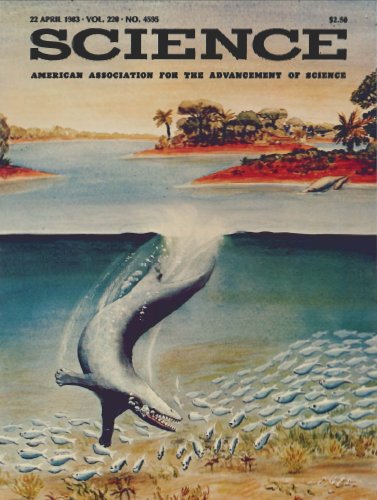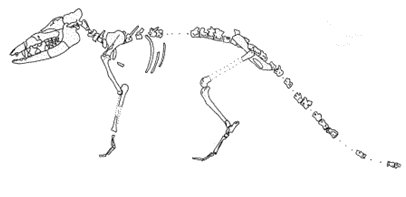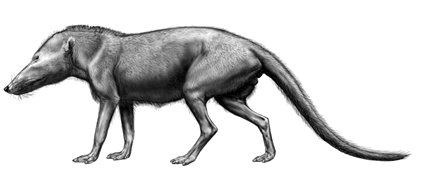I recently received an E-MAIL from a student who attended a March, 2009 debate between me and Dr. Robert A Martin. It reminded me of something that happened in that debate. During one of my rebuttals, I brought up Pakicetus, a supposed ancestor of modern whales. Its fossils were first found in 1983, and the researchers published their findings in the journal Science. The find consisted of parts of the skull, including some teeth. 1
The journal editors thought that the find was incredibly important, because it helped us understand the supposed evolutionary history of whales, so they put the artist’s conception of what Pakicetus looked like on the cover of that issue of the journal:

This picture was the standard, accepted picture of Pakicetus until 2001, when a more complete skeleton was published. 2 The more complete skeleton showed that the “accepted” picture of Pakicetus wasn’t even close to correct.

This led to what is now considered the “correct” view of what Pakicetus looked like:

The reason I brought this up in the debate was that the evolutionist I was debating had written a book called Missing Links: Evolutionary Concepts and Transitions Through Time. Even though the book was published in 2004 (three years after the more complete skeleton was found), it used the 1983 drawing of Pakicetus in its discussion of whale evolution.
Now of course, the scientists involved in this situation can be forgiven for producing such an incorrect drawing back in 1983. After all, they had very little information upon which they could base such a drawing. The important question to ask is, “Why make such a drawing to begin with, given the fact that you have so little evidence upon which to base the drawing?” In chemistry (and in most scientific disciplines), we don’t draw conclusions unless there are sufficient data. Why is evolutionary biology different in this regard?
Well, I think one part of the answer can be found in a very interesting article called Filling in the Blanks. This article discusses the experience of Medical illustrator Ronald J. Ervin. He and another artist were commissioned to produce some illustrations for a university-level textbook, Raven and Johnson’s Biology. He says that when he drew his interpretation of Australopethecus, one of the creatures that is supposed to be part of the evolutionary history of man, the authors weren’t initially happy.
I was told to make her more ape-like, or more “transitional” in appearance…I had been given a cast of a skull, and I was shown some drawings other artists had done of “Lucy,” and was asked to improve on these—to make her look more transitional. I had to make some things up, while keeping the anatomical bones intact, like the temple bone and other features which are standard.
So in the end, Ervin had to “fiddle” with the picture until it looked like something the authors wanted – a transitional form that fit where they wanted it to fit in the supposed evolutionary history of man.
I think this is at least one reason why paleontologists like to have artists make drawings of what a creature supposedly looked like, regardless of whether or not there is enough evidence to make a reasonable drawing. After all, if I want to convince people evolution happened, it is nice to have a lot of leeway in the drawings I use. That way, I can force my views on the data, rather than the more uncomfortable situation of allowing the data to force my views.
The take-home message from this discussion is simple – don’t believe the drawings of what these creatures were supposed to have looked like. If someone tries to push a bunch of artist’s drawings on you, ask for drawings of the bones that have actually been found. If you do that, you will come closer to learning what the fossils tell us, and not what some evolutionists want to tell us!
REFERENCES
1. Gingerich, P. D., N. A. Wells, D. E. Russell, and S. M. I. Shah, “Origin of whales in epicontinental remnant seas: new evidence from the early Eocene of Pakistan,” Science 220:403-6, 1983
Return to Text
2. . M. Thewissen, E. M. Williams, L. J. Roe and S. T. Hussain, “Skeletons of terrestrial cetaceans and the relationship of whales to artiodactyls,” Nature 413:277-81, 2001
Return to Text

Hey Dr. Wile,
I watched the debate from the link you provided, and I notice that your debate opponent, Robert Martin, seems to not even know what he is arguing against. This happens on a lot of forum debates too… it seems that most of the time atheists and other evolutionists know (either only or primarily) the caricatures made of the creationist positions but not the actual arguments we use. Sometimes, annoyingly, they will argue that the caricatures are the actual ones and any deviation from the caricature and, poof, name calling and insinuation commences. Some are more subtle than others in their insults, but the lack of ability to listen to their opponent seems nearly constant.
Ben, you are quite right about evolutionists mischaracterizing creationists. They do it all the time. For example, in Dr. Coyne’s book, Why Evolution is True, he continually mischaracterizes creationists. For example, at one point he asks, “Why would a creator put a pathway for making vitamin C in all these species, and then deactivate it?” (p. 73). This, of course, is not what creationists think happened. Had Dr. Coyne bothered to investigate what creationists actually think, he would know that creationists think that this gene has been deactivated by MUTATION.
Of course, most evolutionists don’t have any idea what creationists think about the data. That’s because they don’t bother to INVESTIGATE what creationists think. Whether this is the result of laziness, fear, or something else, I cannot say.